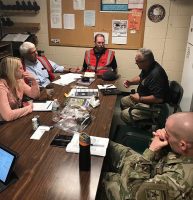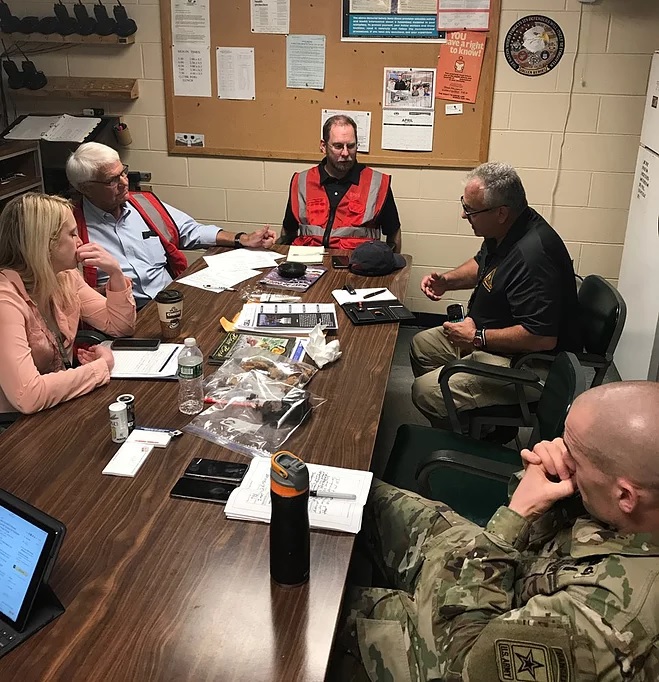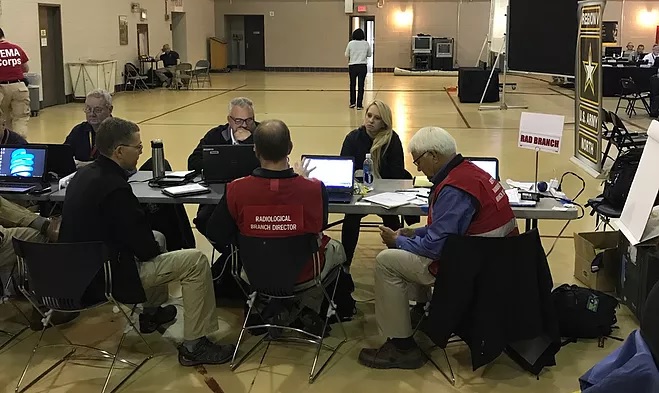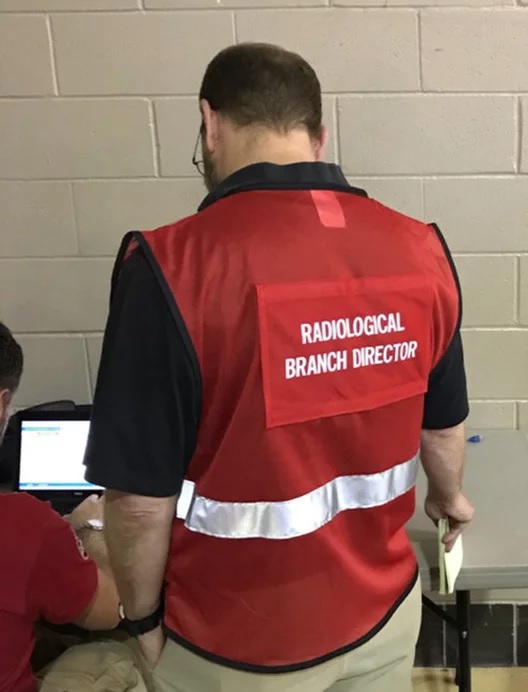The spectrum of EMSI’s incident management acumen was on full display with the execution of Gotham Shield 2017, a FEMA-led exercise involving local, state, and Federal response to a nuclear detonation in the United States. The exercise, taking place primarily in New York and New Jersey, is the latest in the Vibrant Response exercise series. EMSI personnel played key roles in a number of activities in both planning for the exercise and responding to the simulated event alongside its Federal government clients. Supporting its government clients in this effort since 2013, EMSI has a proud history of contributing to the Vibrant Response exercises.
Exercise Planning
The Gotham Shield 2017 was the culmination of a twelve-month development process involving scores of exercise planners from local, state, Federal, and private sector entities. EMSI’s Dr. Wendy Chernesky served on the exercise planning team representing the U.S. Department of Energy (DOE) National Nuclear Security Administration (NNSA). Bringing her background in radiological consequence management to bear, Wendy provided technical subject matter expertise as part of the exercise scenario and evaluation development. Her participation in the planning process ensured a realistic scenario provided a challenging experience for all the participating organizations.
Exercise Control & Simulation
In addition to her planning role, Dr. Chernesky supported exercise control and simulation activities during the Gotham Shield 2017 execution. In support of the vast number of scientific and technical questions that the Gotham Shield scenario raised, the DOE/NNSA Consequence Management Home Team (CMHT) stood up for the duration of the exercise. This DOE/NNSA asset is a component of the Federal Radiological Monitoring and Assessment Center (FRMAC) and contains nodes from national labs throughout the country. Team members host a range of skills, from scientific and health physics experts to logisticians and Graphic Information System (GIS) staff. In addition, the National Atmospheric Release Advisory Center (NARAC) and their predictive plume model capabilities are accessible through the CMHT.
A critical output of the CMHT is the map products and technical reports that enable decision makers to better understand the radiological hazards to workers and to the public. During the exercise, these maps were released through liaisons that were deployed to each Emergency Operations Center (EOC) and Joint Field Office (JFO) that was activated during the week. Dr. Chernesky worked closely with CMHT personnel as they fielded many questions and participated in numerous discussions to support the response effort.
Policy & Procedure Development
Previous Vibrant Response exercises revealed gaps in how radiological response resources were coordinated and managed at the JFO level. Players and evaluators noted that the pool of specialized resources needed for an incident of this nature is very small and the need to prioritize and deconflict their use is critical for a successful response.
Based on these lessons learned, EMSI’s Billy Haley and Ted Jakubowski worked with DOE/NNSA and FEMA’s National Incident Management Assistance Teams (IMATs) to develop a concept for establishing a Radiological Branch within the JFO Operations Section to deal with these resource management issues. The concept was given a limited test during Vibrant Response 2016, primarily involving DOE/NNSA personnel coordinating environmental monitoring resources. The Radiological Branch concept was more fully implemented in Gotham Shield 2017, bringing in personnel from the U.S. Department of Health and Human Services (HHS), the Occupational Health and Safety Administration (OSHA), and Environmental Protection Agency (EPA) to incorporate the needs of population monitoring and responder safety.
Training & Workshops
EMSI’s expertise in ICS system, position, and team training were put to work supporting several Federal and state organizations in the lead up to Gotham Shield 2017. In a previous blog post, we noted that EMSI had recently delivered Intermediate Incident Command System (ICS-300) and Staging Area Manager (ICS-236) training to the Department of Defense (DOD) Joint Task Force Civil Support (JTF-CS) in Fort Eustis, Virginia. The JTF-CS personnel put this training to use in several Gotham Shield 2017 venues, while fulfilling their role in defense support to civil authorities.
EMSI also combined its experience in both radiological emergency response and incident management by delivering several training courses and workshops to responders participating in the exercise. In support of its DOE/NNSA customer, EMSI has provided ICS position and team training for DOE’s Radiological Assistance Program (RAP) and Consequence Management Response Team (CMRT) since 2007. Personnel from CMRT and RAP Regions 1 and 2 participated in Gotham Shield 2017 at state and local EOCs as well as JFOs in both New York and New Jersey.
In support of the State of New Jersey, EMSI also delivered a workshop on Nuclear and Radiological Incident Management, highlighting the impacts of radiological incident and focusing on:
- The cascading effects of a 10kt nuclear detonation, including impacts from nuclear fallout and blast pressure;
- Strategies for organizing and managing the response to an IND detonation; and the
- Impacts to all-hazards operations and decision-making.
Over the last three years, EMSI has conducted workshops on behalf of DOE/NNSA serving as an educational and planning forum to better prepare FEMA’s National IMATs for nuclear and radiological incidents. Additionally, EMSI has presented at the National Radiological Emergency Preparedness (NREP) Conference and the Health Physics Society (HPS).
Exercise Players
Since 2007, EMSI has provided incident management experts to serve as on-call responders and surge support personnel to DOE/NNSA. During the Gotham Shield 2017 exercise, EMSI’s Buck Latapie, Don Will, and Ted Jakubowski responded as part of DOE’s JFO support team in Albany, NY, standing up and running the Radiological Branch in the Operations Section of the New York JFO. These personnel served as Director and Deputy Directors of the Branch, implementing incident management practices outlined in the Radiological Branch concept developed by FEMA, DOE/NNSA, and EMSI. While the primary responsibility of the Radiological Branch was to coordinate radiological response resources at the JFO level, it also served as a hub for technical advice related to the radiological hazard faced in the scenario.
EMSI Experience
EMSI’s vast experience in complex incident management and hazardous materials response has helped inform some of the advanced incident management approaches to Chemical, Biological, Radiological, and Nuclear (CBRN) incident management. EMSI personnel have been involved in the management of several complex hazardous materials incidents, including Anthrax at the Capital (2001), the oil and hazardous materials response following Hurricanes Katrina and Rita (2005), Deepwater Horizon oil spill (2010), the Fukushima Daiichi Nuclear Disaster (2011), and the oil and hazardous materials response following Hurricane Sandy (2012).
EMSI has provided ICS and incident management training and support to DOE since 2007 and routinely provides support to DOE exercises. In 2011, EMSI Vice President of Operations Billy Haley responded to Japan with DOE as part of the U.S. Government’s response to the Fukushima Daiichi Nuclear Disaster. For his contributions, Billy earned the DOE Secretarial Honor Award and the U.S. Agency for International Development (USAID) Meritorious Group Award. With a deep and seasoned cadre of Type 1 ICS practitioners and exercise planners, including Master Exercise Practitioners (MEPs), EMSI is uniquely positioned to provide development, coaching, and mentoring support to exercises. Visit our website at www.emsics.com or contact us to find out how we can help your organization’s preparedness posture.





